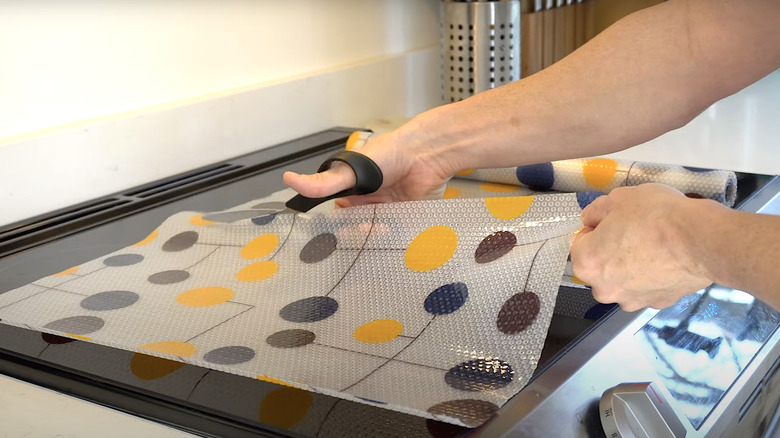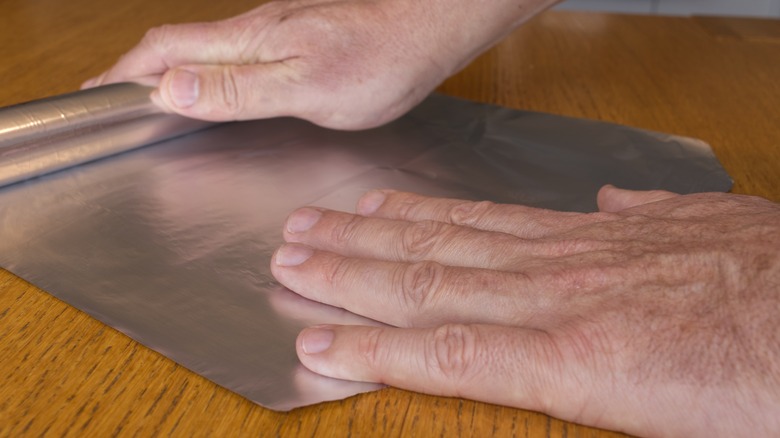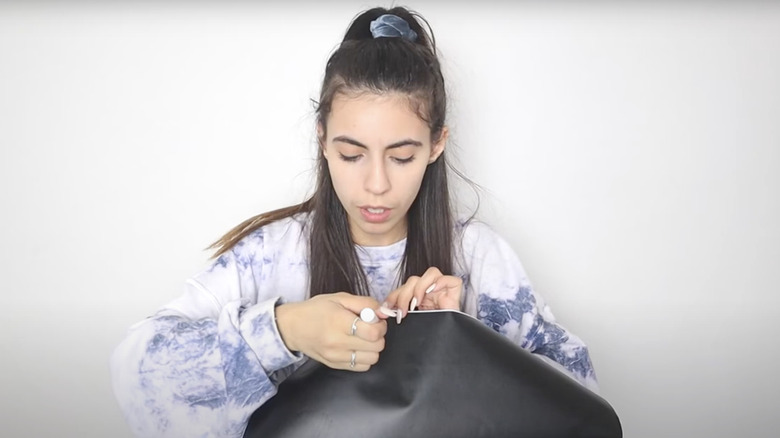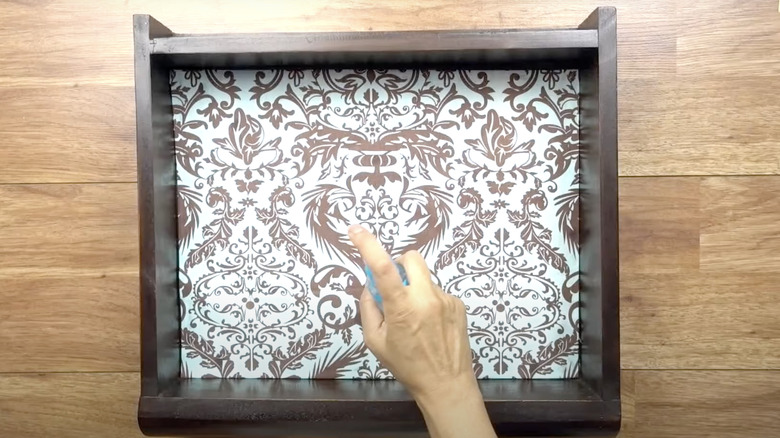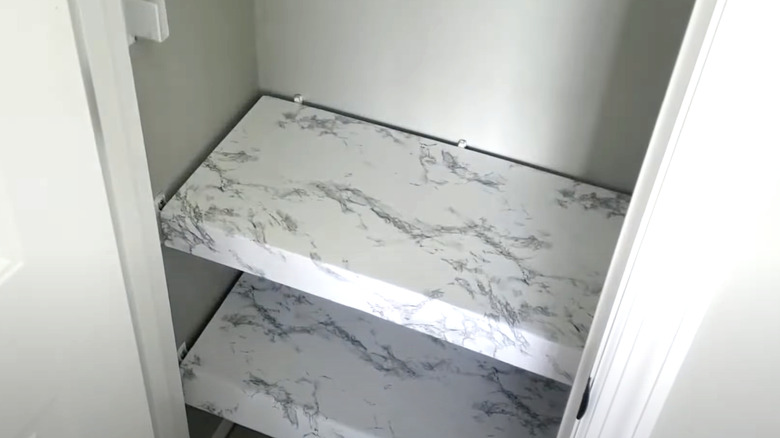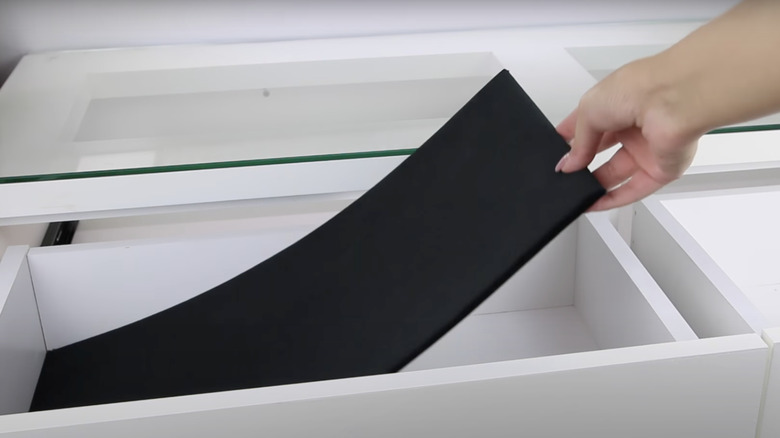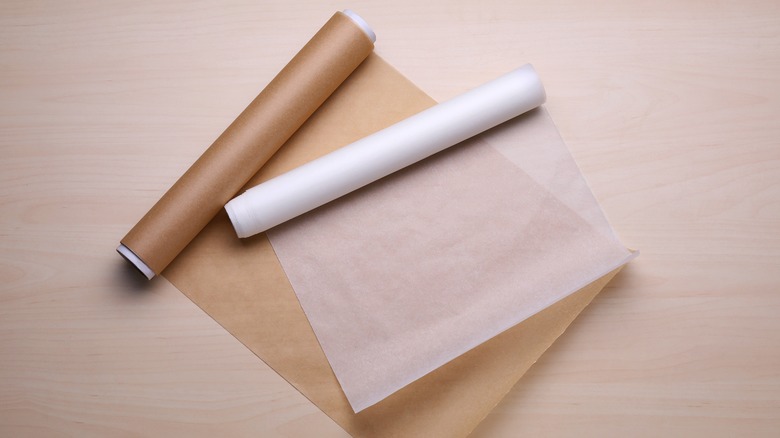12 Easy DIY Liners You Can Use In Your Cabinets And Drawers
Cabinet and drawer liners are an easy household upgrade. They're usually made of paper, vinyl, fabric, or another lightweight material that can easily slide over other surfaces to provide a protective barrier. They can be soft, hard, textured, or smooth, but all still serve a similar purpose. These budget-friendly features add practicality and aesthetic value to storage spaces around your home. They cushion fragile objects, help keep items in place, and add color to dull shelves and surfaces.
There are dozens of ways to fashion liners from items you already own or inexpensive materials found at local craft and home improvement stores. It doesn't take advanced tools or machinery to measure your storage space; cut the liner into the correct shape and size and slide it into place. Below are 12 DIY liner ideas that are easy and quick to assemble. Read on to learn what supplies you may need and how you can efficiently complete each project.
Wrapping paper adds a decorative touch in drawers
Start by searching for discount wrapping paper at local dollar stores or online retailers. You'll also need scissors, a ruler or measuring tape, a flat-style paintbrush, and Mod Podge, which you can purchase from a local hardware or drugstore. Measure the dimensions of your drawer's interior, and cut the wrapping paper to the same length and width. Apply the Mod Podge sealant to the inside of your drawer and lay the wrapping paper overtop, carefully smoothing it out from one side to the other. Apply more layers of the sealant to affix it in place.
Felt can cushion spaces containing fragile belongings
Felt is a great liner for storage spaces with fragile belongings. Purchase self-adhesive felt liner or felt material from a local or online craft supply store. You'll also need a measuring tool and scissors. Find the length and width of your drawers, and cut the material to match the dimensions. When using the adhesive version, peel off the back before sticking it to the surface. However, when using the non-adhesive version, tightly tuck the felt against all sides. If you intend to pad the edges of your drawer's interior for extra cushioning, cut the fabric a half-inch larger on all sides.
Peel-and-stick wallpaper creates a surprisingly pretty interior
If you have peel-and-stick wallpaper left over from a home renovation project, reuse the scraps to embellish cabinets and drawers. You can also purchase new rolls at home improvement stores and popular retail chains. Measure the size of your drawers or shelves and trim the paper to the same dimensions. Don't remove all the adhesive at once, but peel it off slowly as you smooth down the paper over the bottom of the drawer. Use a utility blade to trim any overlapping edges.
Placemats work as standalone inserts in drawers
Placemats are typically 12 by 18 inches, and if you're lucky to have shelves or drawers near this size, you can use them as DIY liners. However, if the drawers are smaller, you can use vinyl placemats and cut them to size. Order a set online, or visit a local home goods or discount store. Setting them up is easy; empty your cabinets and drawers and lay the placemats down for a cushioned and improved interior look.
Aluminum foil's reflectiveness brightens storage space
Aluminum foil is a household staple you're sure to own for other purposes. Repurpose it as a shelf liner by rolling out a sheet and pressing it against the inside of your cabinet. The metallic surface reflects light from overhead bulbs, helping to illuminate cabinets and drawers. This is advantageous in darker rooms and deep storage spaces. Throw away the foil as it gets crinkled and dirty, replacing it with a fresh sheet as needed. If you want something more exciting than silver, you can order gold aluminum foil online.
Cork board is soft and keeps items in place in drawers
Purchase cork in roll or as individual sheets from a home goods store. This material is ideal for kitchen storage spaces because it absorbs moisture and provides padding. These characteristics prevent dinnerware and glassware from being accidentally chipped and scratched. Since the cork absorbs excess water, it also keeps dishes from sitting in water, ensuring they're dry when you take them out for use. Cork lining is also biodegradable, which reduces waste when it comes time to replace it with a new set.
Vinyl floor tiles are a moisture-resistant option for utility shelves
Linoleum peel-and-stick tiles are inexpensive and are a practical solution for sturdy shelving spaces. Like many other DIY liners, these tiles have a self-adhesive lining, making it easy to peel off the backs and stick them to your shelves. Feel free to use the cheapest linoleum you can find; choosing a lightweight variety is fine since they aren't exposed to foot traffic. Clean them using a natural solution like vinegar and baking soda. Avoid floor cleaners to prevent harsh chemicals from contaminating kitchen and bathroom items.
Chalkboard contact paper keeps shelves organized
Chalkboard-style liner is another unique DIY product for overlaying shelves. Purchase a self-adhesive liner and wet-erase chalkboard markers. Cut the chalkboard paper into the same size as your storage space and overlay the shelves. Label designated spots and spaces with the markers to optimize organization. This is a great method for young children's bathrooms or toy cabinets, testing their reading comprehension and encouraging them to stay tidy. Just be wary that the marker will smudge if exposed to moisture.
Contact paper and essential oils make a scented drawer liner
Dressing up your cabinet and drawer interiors makes them prettier, and you can also enhance their scents. Add fragrant essential oils to either contact paper or a fabric lining. Order a one-ounce spray bottle and essential oils from online retailers or drug stores. Fill the spray bottle with warm water and about 30 drops of your chosen essential oil smell. Spritz the concoction over the liner to leave a pleasant lingering scent. The formula should be non-toxic since essential oils are safe in small amounts.
Decorative contact paper secured over foam board hides wire shelving
Wire shelving isn't common in drawers but is popular in cabinets, especially if you utilize wire shelf risers to create more storage space. You can hide the unattractive wire shelving using a pack of contact paper and foam boards. Either purchase the foam boards pre-cut to the same dimensions as your shelves or cut them with a utility knife or scissors at home. Wrap the contact paper around the foam, using the included self-adhesive to stick them together. Secure the wrapped foam to the wire shelves using a super-hold clear tape.
Velvet over cardboard creates a luxurious storage lining
Velvet offers a more stylish look than felt. When used as a liner, it creates elegant and soft storage spaces. Use leftover cardboard boxes from other purchases or online orders. If you don't have any leftovers, purchase cardboard sheets alongside velvet fabric and tacky glue at a local craft store. Cut the cardboard and fabric as you would with other ideas on this list, adhering the velvet to the cardboard with glue. Slide the completed piece at the bottom of a cabinet or drawer, and start storing your belongings immediately.
Re-purpose parchment paper and washi tape in storage spaces
Parchment paper is another household essential you'll likely find packed next to your aluminum foil rolls. Use measuring tape and scissors to cut the paper to the exact measurements for your storage space remodel. Tear off a sheet of parchment paper and use washi tape to decorate and secure it to the interior surfaces of cabinets and drawers. Replace the parchment and tape as they get dirtied and torn over time. If you want a prettier interior, you can always order patterned parchment paper for a more vibrant look.
